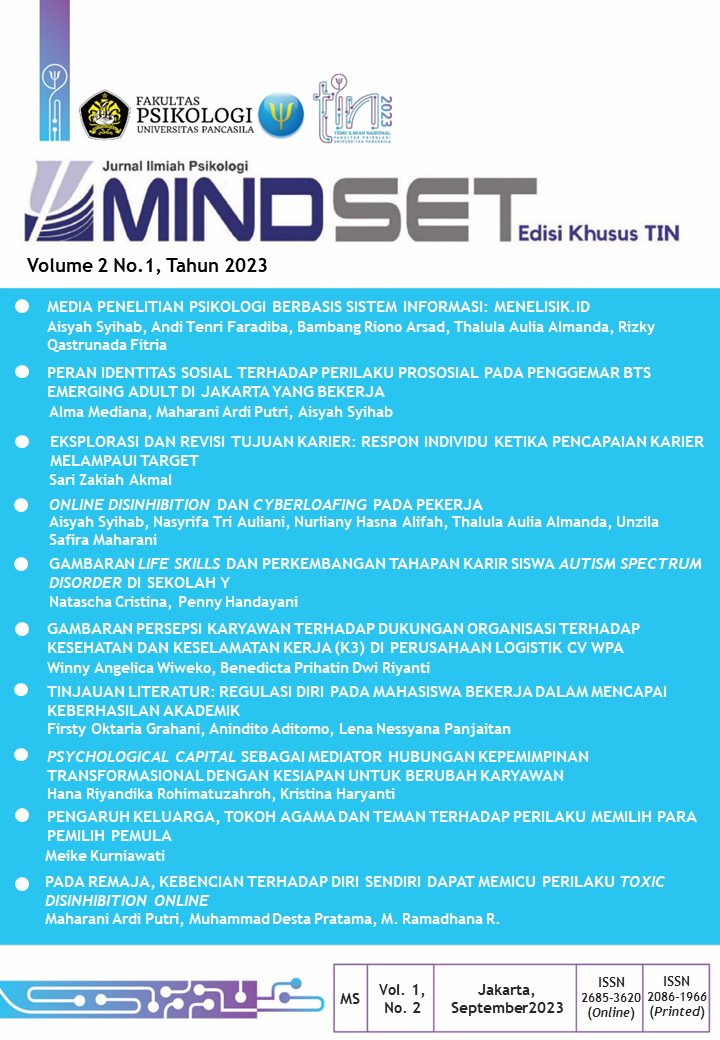Media Penelitian Psikologi Berbasis Sistem Informasi: menelisik.id
DOI:
https://doi.org/10.35814/mindset.v2i01.5507Kata Kunci:
alat ukur, Big Five Inventory, media penelitian psikologi, sistem informasiAbstrak
Sejauh ini belum tersedia media penelitian, khususnya pada bidang Psikologi berbasis sistem informasi yang dapat menyediakan reward langsung kepada responden berupa hasil self-report responden pada suatu penelitian. Media penelitian yang sudah ada saat ini hanyalah mengambil data responden dan tidak dapat memberikan reward secara langsung. Reward biasanya berupa pulsa yang diberikan secara acak kepada perwakilan responden yang terpilih dengan cara diundi. Hal tersebut kurang sesuai dengan etika penelitian. Oleh karena itu dibutuhkan media penelitian psikologi berbasis sistem informasi yang dapat digunakan oleh banyak peneliti psikologi, seperti dosen dan mahasiswa, sehingga penelitian ini penting untuk dilakukan. Penelitian ini dibedakan menjadi dua tahap yaitu tahap uji validitas dan reabilitas alat ukur yang menjadi pionir pada sistem informasi ini serta tahap perancangan dan pengaplikasian sistem informasi tersebut. Alat ukur yang menjadi pionir untuk diaplikasikan pada menelisik.id adalah Big Five Inventory Extra Short Forms 2 (BFI-2-XS) dari Soto dan John (2017). Website menelisik.id berhasil dirancang dan diaplikasikan, sesuai dengan tujuan penelitian. Terdapat 241 orang responden yang menggunakan alat ukur BFI-2-XS pada menelisik.id, dengan paling banyak berada pada kategori tinggi untuk dimensi agreeableness. Selain itu, responden juga diminta untuk mengisi survei kepuasan pengguna menelisik.id, di mana hasilnya adalah sebanyak 51,9% responden merasa puas. Untuk selanjutnya, menelisik.id akan diproses HKI dan dibuat agar lebih user friendly untuk para peneliti baik dosen maupun mahasiswa Fakultas Psikologi Universitas Pancasila.
Referensi
Costa, P. T., & McCrae, R. R. (1992). Normal personality assessment in clinical practice: The NEO Personality Inventory. Psychological Assessment, 4(1), 5–13. https://doi.org/10.1037/1040-3590.4.1.5
Cozby, P. & Bates, S. (2018). Methods in behavioral research (13th ed.). McGraw-Hill.
Crain, W. (2005). Theories of development: Concept and applications (5th ed.). Pearson Educational LTD.
Feist, J., & Feist, G. J. (2009). Theories of personality (7th ed.). McGraw-Hill.
GCFGlobal. (n.d.). Using Forms with Google Classroom. Edu.Gcfglobal.Org. https://edu.gcfglobal.org/en/google-forms/using-forms-with-google-classroom/1/#
Hair, J. F., Black, W. C., Babin, B. J., & Anderson, R. E. (2019). Mulitivariate data analysis (8th ed.). Cengage Learning.
Halida, A. (2021). Sehat Mentalkah, Saya? RS Jiwa Grhasia DIY. https://grhasia.jogjaprov.go.id/berita/377/sehat-mentalkah-saya.html
KBBI Daring. (2016). Arti kata “selisik.” Kbbi.Kemendikbud.Go.Id. https://kbbi.kemdikbud.go.id/entri/selisik
Laudon, K. C., Laudon, J. P., & Elragal, A. (2015). Management information systems. Person Education LTD.
Lemeshow, S., Hosemer, D.W., Klar, J., & Lwanga, S.K., (1997). Besar sampel dalam penelitian kesehatan. Diterjemahkan dari Adequacy of sample size in health studies oleh Pramono, D. Universitas Gadjah Mada
McNeish, D. (2018). Thanks coefficient alpha, we’ll take it from here. Psychological Methods, 23(3), 412–433. https://doi.org/10.1037/met0000144
Mosley, L. (2016). The importance of understanding personality type in the workplace. Linkedin.Com. https://www.linkedin.com/pulse/importance-understanding-personality-type-workplace-
Musek, J. (2017). The general factor of personality. Academic Press.
Myers, I. B. (1998). MBTI Manual: A Guide to the Development and Use of the Myers-Briggs Type Indicator (3rd ed.). Consulting Psychology Press, Inc.
Nsd.co.id. (n.d.). Psikotes Online Permudah Proses Asesmen. Nsd.Co.Id. https://nsd.co.id/psikotes-online
Pan, B., Woodside, A. G., & Meng, F. (2013). How contextual cues impact responses and conversion rates of online surveys. Journal of Travel Research, 53(1), 58–68. https://doi.org/10.1177/00472875134841
Rainer, R. K., Prince, B., & Cegielski, C. G. (2013). Introduction to information systems (5th ed.). Wiley Publishing.
Rosa, A. S. & Shalahuddin, M. (2018). Rekayasa perangkat lunak terstruktur dan berorientasi objek. Informatika.
Soto, C. J., & John, O. P. (2017). The next Big Five Inventory (BFI-2): Developing and assessing a hierarchical model with 15 facets to enhance bandwidth, fidelity, and predictive power. Journal of Personality and Social Psychology, 113(1), 117–143. https://doi.org/doi.org/10.1037/pspp0000096
Sugiyono. (2007). Metode penelitian kuantitatif, kualiatif dan R & D. Alfabeta.
SurveyMonkey. (n.d.). Mengapa SurveyMonkey Lebih Baik dari Google Forms. SurveyMonkey.Com. https://www.surveymonkey.com/mp/mengapa-surveymonkey-lebih-baik-dari-google-forms/#:~:text=SurveyMonkey menawarkan berbagai fitur yang,karyawan dan kepuasan pelanggan%2C serta
Uhlig, C.E., Seitz, B., Eter, N., Promesberger, J., & Busse, H. (2014). Efficacies of Internet ased digital and paper-based scientific surveys and the estimated costs and time for different sized cohorts. PIOS ONE, 9(19), 1–11.









